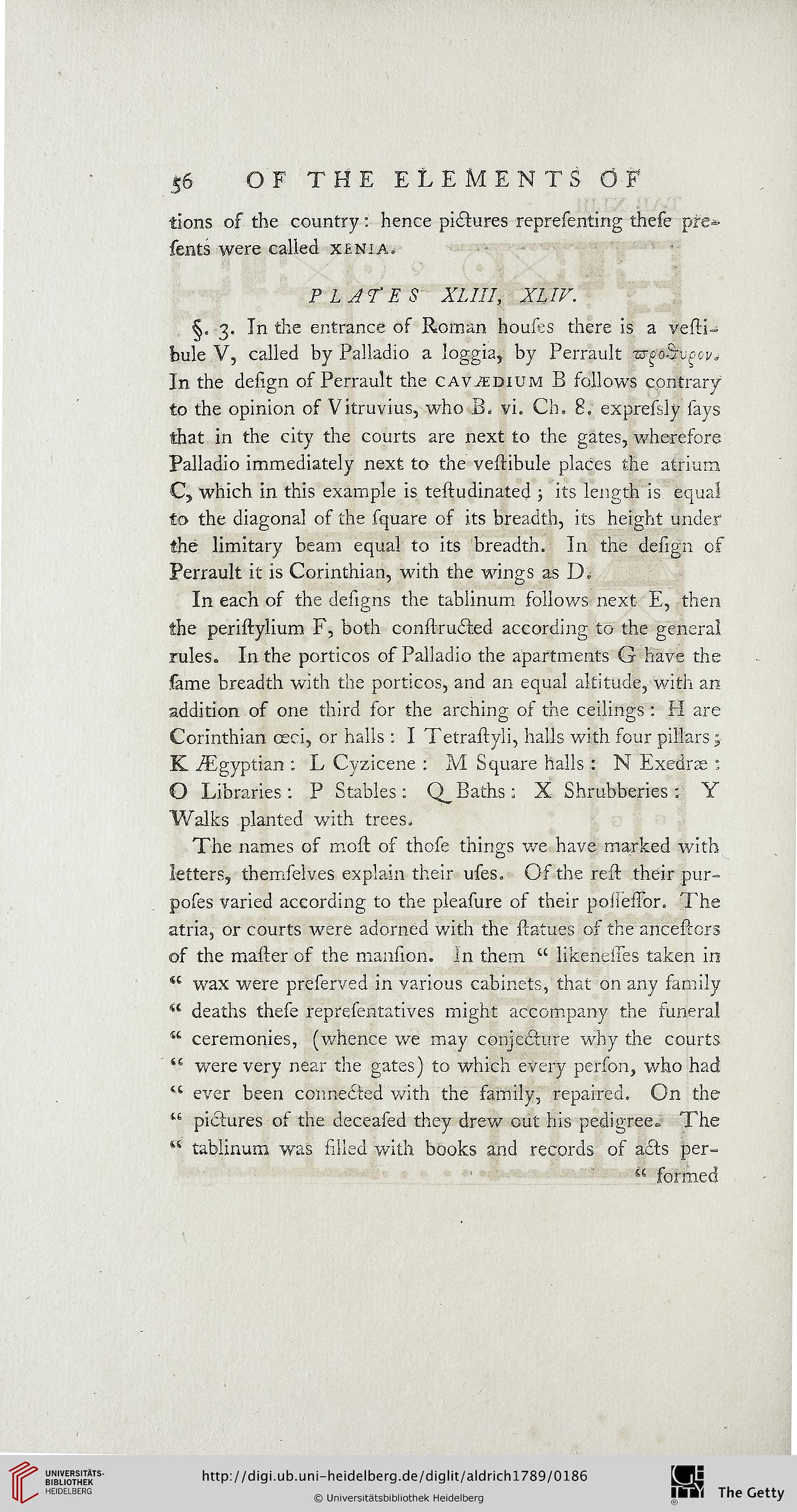56 OF THE ELEMENTS OF
tions os the country: hence pictures representing these pre*-
sents were called xenia.
PLATES XL1I1, XL IV.
§. 3. In the entrance of Roman houses there is a vesti-
bule V, called by Palladio a loggia, by Perrault zrgoSxvgcv*
In the design os Perrault the cavjedium B follows contrary
to the opinion of Vitruvius, who B. vi. Ch. 8. expressly says
that in the city the courts are next to the gates, wherefore
Palladio immediately next to the vestibule places the atrium
C, which in this example is testudinated ; its length is equal
to the diagonal of the square of its breadth, its height under
the limitary beam equal to its breadth. In the design os
Perrault it is Corinthian, with the wings as D*
In each of the designs the tablinum follows next E, then
the peristylium F, both construcfted according to the general
rules. In the porticos of Palladio the apartments G have the
same breadth with the porticos, and an equal altitude, with an
addition of one third for the arching of the ceilings : PI are
Corinthian ceci, or halls : I Tetrastyli, halls with four pillars;
K ./Egyptian : L Cyzicene : M Square halls : N Exedrae ;
O Libraries: P Stables: Baths: X Shrubberies: Y
Walks planted with trees.
The names of most os those things we have marked with
letters, themselves explain their uses. Of the rest their pur-
poses varied according to the pleasure of their posteffor. The
atria, or courts were adorned with the statues os the ancestcrs
of the master of the mansion. In them u likenesses taken in
*c wax were preserved in various cabinets, that on any samily
u deaths these representatives might accompany the suneral
“ ceremonies, (whence we may conjecture why the courts
“ were very near the gates) to which every person, who had
<l ever been connected with the family, repaired. On the
“ pictures of the deceased they drew out his pedigree. The
u tablinum was filled with books and records os afts per-
a formed
tions os the country: hence pictures representing these pre*-
sents were called xenia.
PLATES XL1I1, XL IV.
§. 3. In the entrance of Roman houses there is a vesti-
bule V, called by Palladio a loggia, by Perrault zrgoSxvgcv*
In the design os Perrault the cavjedium B follows contrary
to the opinion of Vitruvius, who B. vi. Ch. 8. expressly says
that in the city the courts are next to the gates, wherefore
Palladio immediately next to the vestibule places the atrium
C, which in this example is testudinated ; its length is equal
to the diagonal of the square of its breadth, its height under
the limitary beam equal to its breadth. In the design os
Perrault it is Corinthian, with the wings as D*
In each of the designs the tablinum follows next E, then
the peristylium F, both construcfted according to the general
rules. In the porticos of Palladio the apartments G have the
same breadth with the porticos, and an equal altitude, with an
addition of one third for the arching of the ceilings : PI are
Corinthian ceci, or halls : I Tetrastyli, halls with four pillars;
K ./Egyptian : L Cyzicene : M Square halls : N Exedrae ;
O Libraries: P Stables: Baths: X Shrubberies: Y
Walks planted with trees.
The names of most os those things we have marked with
letters, themselves explain their uses. Of the rest their pur-
poses varied according to the pleasure of their posteffor. The
atria, or courts were adorned with the statues os the ancestcrs
of the master of the mansion. In them u likenesses taken in
*c wax were preserved in various cabinets, that on any samily
u deaths these representatives might accompany the suneral
“ ceremonies, (whence we may conjecture why the courts
“ were very near the gates) to which every person, who had
<l ever been connected with the family, repaired. On the
“ pictures of the deceased they drew out his pedigree. The
u tablinum was filled with books and records os afts per-
a formed





